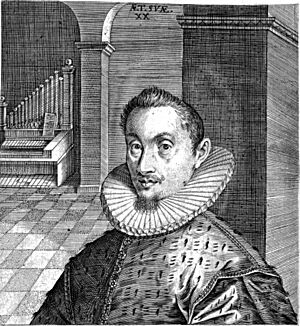Hans Leo Hassler facts for kids
Hans Leo Hassler (born in Nuremberg and baptized on October 26, 1564 – died June 8, 1612) was an important German composer and organist. He lived during the late Renaissance and early Baroque periods. His older brother, Jakob Hassler, was also a composer, but not as well known.
Contents
A Musician's Journey
Hans Leo Hassler was born in Nürnberg (now Nuremberg). He learned music from his father, Isaak Hassler, who was an organist. In 1584, Hassler became one of the first German composers to travel to Italy to continue his studies. He arrived in Venice when the Venetian school of music was very active. This school was famous for its grand polychoral style, which used multiple choirs singing together.
While in Venice, Hassler became good friends with Giovanni Gabrieli, another famous composer. They even wrote a special song together for a wedding in 1600. Both Hassler and Gabrieli studied with Andrea Gabrieli, Giovanni's uncle. Andrea taught Hassler how to compose music and play the organ.
Returning Home
After Andrea Gabrieli passed away, Hassler went back to Germany in late 1585. He moved to Augsburg and became an organist for Octavian II Fugger, a powerful nobleman. These years in Augsburg were very creative for Hassler. He became well-known as a composer and organist. Even though he was a Protestant in a mostly Catholic area, his influence grew.
Organ Expert and Inventor
Hassler was not just a composer; he was also a skilled organist and helped design organs. In 1596, he was one of 53 organists who checked out a huge new organ in Groningen. People often asked for his advice on organ design because he was so knowledgeable.
Using his deep understanding of organs, Hassler even invented a special clockwork organ. This amazing instrument was later sold to Emperor Rudolf II.
Later Life and Legacy
In 1602, Hassler returned to Nürnberg and became the Kapellmeister, which means the director of town music. He was also appointed as a Kaiserlicher Hofdiener (court servant) for Emperor Rudolf II. In 1604, he took a break to travel to Ulm and marry Cordula Claus.
Four years later, Hassler moved to Dresden. There, he worked as the electoral chamber organist for Elector Christian II of Saxony. Eventually, he became the Kapellmeister there too. Sadly, by this time, Hassler had already developed tuberculosis, a serious illness. He passed away in June 1612. After his death, famous composers like Michael Praetorius and Heinrich Schütz took his place.
Hassler's Music Style
Hans Leo Hassler was one of the first composers to bring the exciting new Venetian music style across the Alps into Germany. Through his songs and collections like the Lustgarten, he introduced German listeners to popular Italian dance songs and vocal pieces.
Because Hassler was the first major German composer to study in Italy, his influence was huge. He helped make Italian music very popular in Germany. While older composers like Lassus were still writing in the older, refined Renaissance style, new trends were appearing in Italy. Hassler, and later Schütz, brought these new ideas, like the concertato style (which uses contrasting groups of instruments or voices) and the idea of multiple choirs, into German music. This helped create the first important Baroque music outside of Italy.
Blending Styles
Even though Hassler was Protestant, he wrote many masses (religious music for church services) and directed music for Catholic services in Augsburg. Because he worked for Catholic patrons and also had his own Protestant beliefs, Hassler's music cleverly blended both religious styles. This meant his compositions could be used in both Catholic and Lutheran churches.
His early music showed the influence of Lassus, while his later works clearly showed what he learned in Italy. After returning from Italy, Hassler used polychoral techniques (multiple choirs), different textures, and sometimes chromaticism (using notes outside the main scale) in his music.
His later masses had light, graceful melodies mixed with the smooth, flowing style of Italian madrigals (vocal pieces). This created a charming sacred music style. His non-religious music, like madrigals, canzonette, and songs, showed many advanced techniques from the Gabrielis in Italy. However, Hassler's music was often more controlled and always focused on good craftsmanship and beautiful sound.
Hassler's greatest success in mixing German and Italian styles was in his lieder (German songs). In 1590, he released his first collection of twenty-four four-part songs. His most famous collection of lieder is the Lustgarten neuer teutscher Gesang. This work includes many vocal and instrumental pieces.
One of his most famous pieces is Mein G'müt ist mir verwirret. Its melody was later used by Bach in his famous St Matthew Passion and other works.
Like many composers of his time, Hassler tried to combine the fancy Italian style with the traditional German style. He did this in his chorale motets by using a thorough bass (a continuous bass line) and adding instrumental and solo decorations. Hassler's motets show this mix of old and new, reflecting both Lassus's influence and the two-choir style of the Gabrielis.
Hassler is considered one of Germany's most important composers. He used new Italian techniques alongside traditional German ones. This made his music sound fresh without being overly emotional in a modern way. His songs combined vocal and instrumental parts, and his sacred music introduced Italian polychoral structures. These structures later influenced many composers as music moved into the Baroque era.
Works
- Canzonette (Nuremberg, 1590)
- Cantiones sacrae (Augsburg, 1591), including Dixit Maria (motet)
- Madrigals (Augsburg, 1596)
- Neüe teüsche Gesäng nach Art der welschen Madrigalien und Canzonetten (Augsburg, 1596)
- Masses (Nuremberg, 1599)
- Lustgarten Neuer Teutscher Gesäng (Nuremberg, 1601)
- Sacri concentus (Augsburg, 1601 and 1612)
- Psalmen und christliche Gesäng (Nuremberg, 1607)
- Psalmen simpliciter (Nuremberg, 1608)
- Kirchengesäng (Nuremberg, 1608)
- Venusgarten (Nuremberg, 1615) (instrumental music)
- Litaney teütsch (Nuremberg, 1619)
- Trois entrées
See also
 In Spanish: Hans Leo Hassler para niños
In Spanish: Hans Leo Hassler para niños


